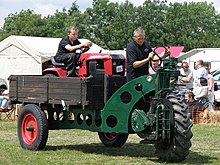Drive wheel
This article needs additional citations for verification. (June 2013) |

A drive wheel is a roadwheel in an automotive vehicle that receives torque from the powertrain, and provides the final driving force for a vehicle.[1] In motor vehicles, "getting power to the ground" is most important because "traction caused by friction between the driven tires and road surface is what makes a car move."[2]
A two-wheel drive vehicle has two driven wheels, and a four-wheel drive has four, and so-on.
A steer wheel is one that turns to change the direction of a vehicle. A trailer wheel is one that is neither a drive wheel, nor a steer wheel.
Drive wheel configurations
Two-wheel drive
For four-wheeled vehicles, this term is used to describe vehicles that are able to transmit torque to at most two roadwheels, referred to as either front- or rear-wheel drive. The term 4x2 is also used, to indicate four total road-wheels with two being driven.
For vehicles that have part-time four-wheel drive, the term "Two-wheel drive" refers to the mode when 4WD is deactivated and torque is applied to only two wheels.
Four-wheel drive or All-wheel drive
Four-wheel drive, 4WD, 4x4 ("four-by-four"), all-wheel drive, and AWD are terms used to describe a four-wheeled vehicle with a drivetrain that allows all four roadwheels to receive torque from the internal combustion engine simultaneously. This system is common in off-road vehicles - powering all four wheels provides better control on loose and slippery surfaces. It is often used in rally racing on mostly-paved roads. Front wheel drive is one wheel drive and a 4x4 has only two wheels driving unless it is limited slip, then two wheel in back where the limited slip is located has traction but the front only one has traction. How ever a jeep rubicon in 4x4 high range has a limited slip in rear so the rear end is two wheel drive but front is one wheel drive, but will go to each wheel where the least resistance is, when in 4x4 high range, but in low range when the lockers are engaged, all 4 wheels will have traction. So cars with front or rear drives are one wheel drive and those with all wheel drive all wheels have traction.
Front-wheel drive
Front-wheel drive (or FWD for short) is a common form of internal combustion engine / transmission layout used in modern passenger cars, where the engine drives the front wheels. Using the front wheels for delivery of power as well as steering allows the driving force to act in the same direction as the wheel is pointing.[3]

A rare example of front wheel drive was the Opperman Motocart. This slow-speed agricultural and light freight vehicle was a tricycle with the front wheel carrying a large tractor tyre. This wheel was powered by a small single cylinder Douglas engine carried on the front monofork that formed the steering gear.
See also Front-engine, front-wheel drive layout.
Rear-wheel drive
Rear-wheel drive (or RWD for short) was a common internal combustion engine / transmission layout used in automobiles throughout the 20th century. RWD typically places the engine in the front of the vehicle, but the mid engine and rear engine layouts are also used.
Notes
- ^ "Driving wheel". thefreedictionary.com. Retrieved 13 July 2013.
any wheel of a vehicle that transforms torque into a tractive force.
- ^ Russ, Carey. "Driving Wheels: Introduction and Rear-Wheel Drive". The Auto Channel. Retrieved 13 July 2013.
- ^ Hillier, V.A.W.; Coombes, Peter (2004). Hilliers Fundamentals of Motor Vehicle Technology (Fifth ed.). Nelson Thornes. p. 263. ISBN 9780748780822. Retrieved 13 June 2013.
See also
- Drive sprocket, the powered sprocket on a tracked vehicle
